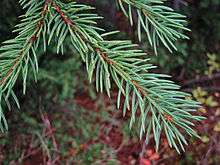Picea engelmannii
| Picea engelmannii | |
|---|---|
 | |
| Foliage and cone | |
| Scientific classification | |
| Kingdom: | Plantae |
| Division: | Pinophyta |
| Class: | Pinopsida |
| Order: | Pinales |
| Family: | Pinaceae |
| Genus: | Picea |
| Species: | P. engelmannii |
| Binomial name | |
| Picea engelmannii Parry ex Engelm. | |
 | |
Picea engelmannii, with common names Engelmann spruce,[1] white spruce,[1] mountain spruce,[1] or silver spruce,[1] is a species of spruce native to western North America, from central British Columbia and southwest Alberta, southwest to northern California and southeast to Arizona and New Mexico; there are also two isolated populations in northern Mexico. It is mostly a high altitude mountain tree, growing at 900 metres (3,000 ft) – 3,650 metres (11,980 ft) altitude, rarely lower in the northwest of the range; in many areas it reaches the alpine tree line.
Description

Picea engelmannii is a medium-sized to large evergreen tree growing to 25 metres (82 ft) – 40 metres (130 ft) tall, exceptionally to 65 metres (213 ft) tall, and with a trunk diameter of up to 1.5 metres (4.9 ft). The bark is thin and scaly, flaking off in small circular plates 5–10 cm across. The crown is narrow conic in young trees, becoming cylindric in older trees. The shoots are buff-brown to orange-brown, usually densely pubescent, and with prominent pulvini. The leaves are needle-like, 15–30 mm long, rhombic in cross-section, glaucous blue-green above with several thin lines of stomata, and blue-white below with two broad bands of stomata.
The cones are pendulous, slender cylindrical, 4–8 cm long and 1.5 cm broad when closed, opening to 3 cm broad. They have thin, flexible scales 15–20 mm long, with a wavy margin. They are reddish to dark purple, maturing pale brown 4–7 months after pollination. The seeds are black, 2–3 mm long, with a slender, 5–8 mm long pale brown wing.
Distribution
Engelmann spruce extends northward at higher elevations in the Cascade, Monashee, Selkirk, and possibly the Rocky Mountains, as well as the highlands surrounding the Interior Plateau.
Both water uptake and water stored in roots appear to be critical for the survival of subalpine Engelmann spruce saplings that are exposed above the snowpack in later winter-early spring.[2] Transpiration is greatly reduced in small saplings while engulfed in snowpack. For exposed trees, the availability of soil water may be critical in late winter, when transpirational demands increase. Increased rates of transpiration in response to loss of snowpack, coupled with low sapwood water reserves and an extended period of soil frost in windswept areas, may prevent Engelmann spruce from regenerating in open areas both above and below the tree line. Cuticular damage by windblown ice is probably more important at the tree line,[3][4] but damage caused by desiccation is likely to be more important at lower elevations.[2]
Subspecies and hybrids
Two geographical subspecies (treated as varieties by some authors, and as distinct species by others) occur:
- Picea engelmannii subsp. engelmannii (Engelmann spruce). All of the range except as below.
- Picea engelmannii subsp. mexicana (Mexican spruce). Two isolated populations on high mountains in northern Mexico, on the Sierra del Carmen in Coahuila (Sierra Madre Oriental) and on Cerro Mohinora in Chihuahua (Sierra Madre Occidental). Engelmann spruces of the Madrean sky islands mountains in the extreme southeast of Arizona and southwest of New Mexico also probably belong to this subspecies, though this is disputed.
The Engelmann spruce hybridises and intergrades extensively with the closely related white spruce (Picea glauca), found further north and east in the Rocky Mountains, and to a lesser extent with the closely related Sitka spruce where they meet on the western fringes of the Cascades.
Uses
Engelmann spruce is of economic importance for its wood, harvested for paper-making and general construction. Wood from slow-grown trees at high altitude has a specialised use in making musical instruments such as acoustic guitars, harps, violins, and pianos. It is also used to a small extent as a Christmas tree.
Predators
Outbreaks of spruce beetles have destroyed millions of Engelmann spruce trees.
Gallery
 Tree
Tree Young tree
Young tree- Section (William O. Douglas Wilderness)
References
- 1 2 3 4 "Montana Plant Life".
- 1 2 Boyce, R.L. and Lucero, S.A. 1999. Role of roots in winter water relations of Engelmann spruce saplings. Tree Physiol. 19:893–898.
- ↑ Hadley, J.L.; Smith, W.K. 1983. Influence of wind exposure on needle desiccation and mortality for timberline conifers in Wyoming, USA. Arctic Alpine Res. 15:127–135. (Cited in Coates et al. 1994).
- ↑ Hadley, J.L.; Smith, W.K. 1986. Wind effects on needles of timberline conifers seasonal influence on mortality. Ecology 67:12–19. Cited in Coates et al. 1994).
Further reading
- Conifer Specialist Group (1998). "Picea engelmannii". IUCN Red List of Threatened Species. Version 2006. International Union for Conservation of Nature. Retrieved 12 May 2006.
- Gymnosperm Database
- US Forest Service: Fire Ecology
- National Audubon Society Field Guide to Trees (Western Region)
External links
| Wikimedia Commons has media related to Picea engelmannii. |
- USDA Plants Profile: Picea engelmannii
- Jepson Manual Treatment - Picea engelmannii
- Flora of North America
- Arboretum de Villardebelle: Picea engelmannii and related spruces - photos of cones
- Picea engelmannii - Photos Gallery
